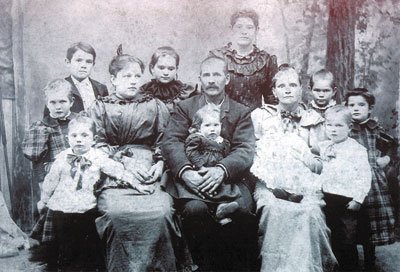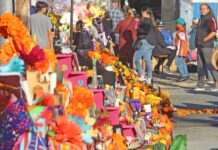Is the color photo of you and your brother turning magenta? Is
that dish your grandmother makes something she learned from her
grandmother?
Is the color photo of you and your brother turning magenta? Is that dish your grandmother makes something she learned from her grandmother? Now is a great time to begin interviewing family members and to begin safely storing documents and photos to ensure the legacy behind them doesn’t pass away with people’s memories.
Family members may be reluctant at first to tell their stories, but most have lessons and values that are important to pass down, says Eileen Putter, a mental-health and grief counselor who also does personal life histories.
“Most people want to feel that they’ll be remembered and also that their lives have had meaning.” So: “Slow down and pay attention,” says Lorraine McConaghy, Seattle’s Museum of History & Industry (MOHAI) historian.
Get people talking
– Use photographs as a prompt and to get people comfortable. If you don’t have your own, view photos from your subject’s eras at local or national Web sites (Library of Congress American Memory, www.memory.loc.gov/ammem/index.html).
“One of the tricks of oral histories is giving people something to talk about,” says McConaghy.
– Ask about the “material culture” of your family. Holiday decorations, dishes, traditions.
McConaghy has Christmas ornaments that belonged to her grandparents, but she never asked about their stories. “So I have them, I value them, but they’re mute.”
– Refresh your knowledge of historical context so you get your subjects to personalize it.
– Ask the hardest questions last. “You want your family members to trust your research and your tact and your good common sense,” McConaghy says.
– Ask follow-up questions either at the time or in subsequent phone calls or interviews. “Do you mean the family walked to the synagogue?” Then, add the answers to the transcript.
– Use a camera. One person should operate the camera and another should ask the questions so the subject forgets about the camera. Use a tripod. Take short footage of favored objects, photos, activities or traditions. Stop and review periodically to make sure the lighting works, the background is simple enough and no extraneous noises are interfering.
Photos
Many color photos taken in the 1950s through 1970s have faded, turning yellow or magenta, says Howard Giske, curator of photography at MOHAI. Early digital prints also were poor. They need to be copied or reprinted from the original film or digital file onto more stable paper.
1. Assess your collection first to establish your priorities so you copy the most meaningful photos before you run out of money and time.
2. Make it a family event but get the dogs, food and drinks out of the room when you get the albums or photos out. Don’t take apart 19th-century tintype photos or their ilk. “You can destroy in 30 seconds something that’s held together for more than 100 years,” Giske says.
3. Information is as important as the photo. Number the photo. Then write the who/what/where onto index cards or computer files indexed to the number, Giske suggests. If you write it on the back of photos, use a photo labeling pencil with soft lead, says Lynn Van Horn, a Seattle-area representative of Creative Memories, a home-based direct sales scrapbook company. Hard lead dents the photo. Ink can bleed through to the front of the photo.
4. Limit exposure of photos (and documents) to direct sunlight and artificial light. Making a few copies with the quick bright light of a copier or scanner appears to be OK, Giske says.
5. Take lots of photos. Candid or posed “with an attitude.” Giske’s grandmother always tried to do something silly. Her photos tell something about the photographer and that the family was having fun.
Preserving photos, stories
– Protect the original but make “preservation” copies and pass them around to other family members or friends so they can be stored separately.
– Use a close-up lens to photograph an old photo, or have it copied professionally. Print digital photos on archival-quality paper with pigmented ink (most quality home printers can do the job, Giske says).
– For documents, take archival-quality paper to copy centers but ask if you can handle the original yourself, suggests Carolyn Marr, MOHAI librarian. Use white gloves to avoid damage from body oils.
– Stay aware of technology changes and be prepared to “migrate” photos, audio or text files to updated media.
– Store photos and videos upright, as you would a book (but anything larger than legal-sized should be stored flat, Marr says).
– Store in cool, dry places away from bright light. Avoid the humidity and wide temperature swings of basements and attics. If an audio or videotape gets hot, let it cool before playing. Play tapes or films once a year to check condition.
Scrapbooks
Done properly, scrapbooks are invaluable. With the wrong material, photos and documents are better off in a shoebox.
1. Look for products that pass the “Photographic Activity Test” and the “International Organization for Standardization” guidelines. The words “acid free” or “photo safe” or “archival quality” are not guarantees.
2. Make the hard decision about what to do with old albums. The acid used in making paper can damage photographs, documents and album pages. Copy old albums, Giske says, but don’t necessarily take them apart, which may cause more damage.
“Magnetic” albums, however, which use a plastic covering to grip photos onto adhesive cardboard pages, are terribly damaging, Giske says. The good news is they are easy to disassemble. “But record carefully how they were set up originally.”
3. The most interesting scrapbooks use mixed media (as opposed to all newspaper clippings). If you have a photo of Aunt Sue in the kitchen, include a recipe in her own handwriting. But enclose the memorabilia in a plastic sleeve or use page protectors to cover your album pages so acid or other substances don’t migrate to the photos.
4. Use only adhesives that have passed the Photographic Activity Test, says Van Horn. Buy from a reputable dealer or contact the manufacturer if you’re not sure. Do not use glue, pins or paper clips.
5. Leave space for information to go along with the items. “You took the photos of this treasured moment for a reason,” Van Horn says. Make sure it’s clear for generations to come.
Doing it yourself
You can sit down with family members to collect information or, if distance is an issue, leave a tape recorder with a family member and call periodically with questions. Also start a Web site that family members can use to post information or photos, or encourage e-mails.
Don’t let indecision on equipment or storage keep you from collecting information, McConaghy says. You can always move the material from format to format. Practice with the equipment.
Hiring a professional
– Families sometimes pool their money to get an older family member’s histories recorded for birthday or anniversary gifts. Hiring someone is a way to make sure the task doesn’t get put off, says Putter of Sundance Life Histories. Plus, a professional doesn’t bring family baggage.
– To find local historians or learn more, visit the Association of Personal Historians www.personalhistorians.org. Prices range from $300 to $10,000 and more.
– Ask about cost, technique, experience, samples and references.













